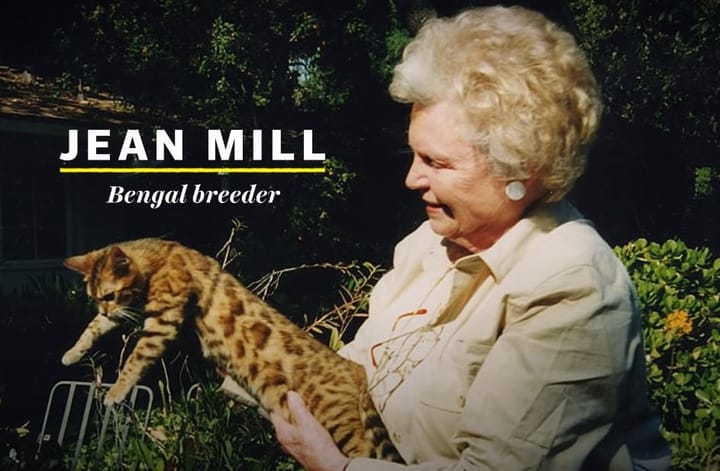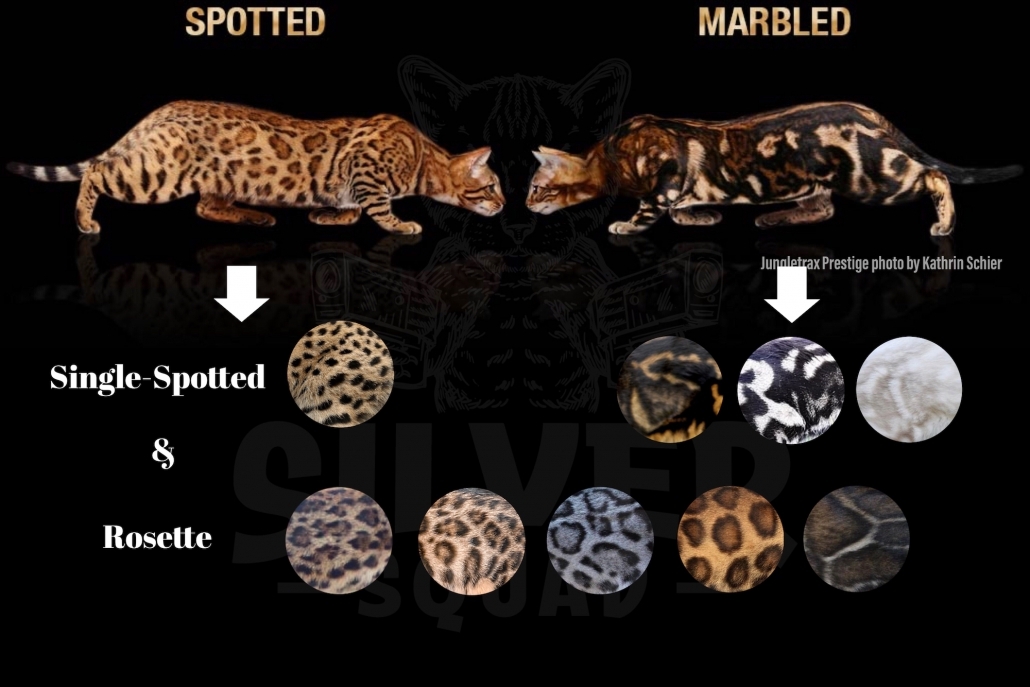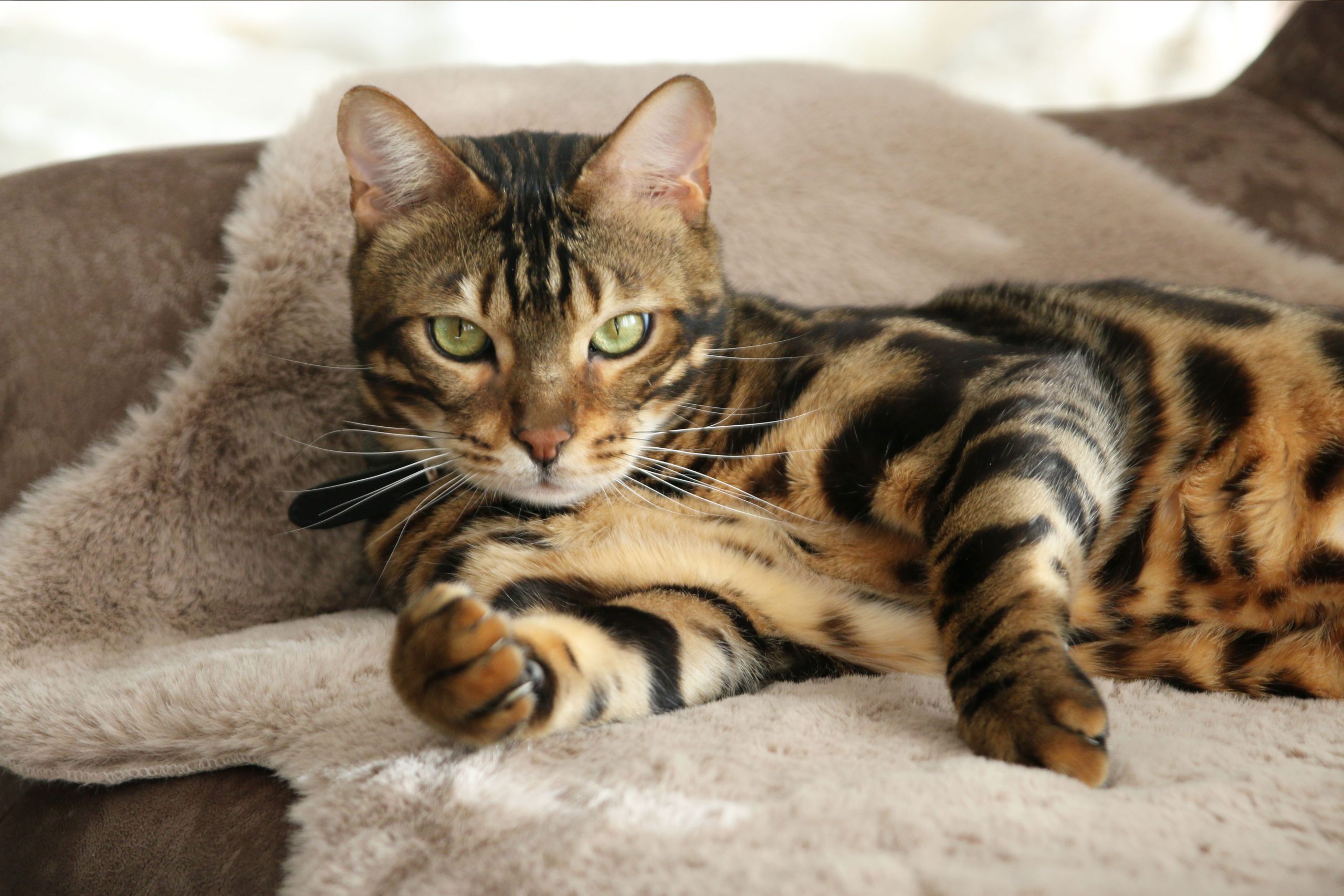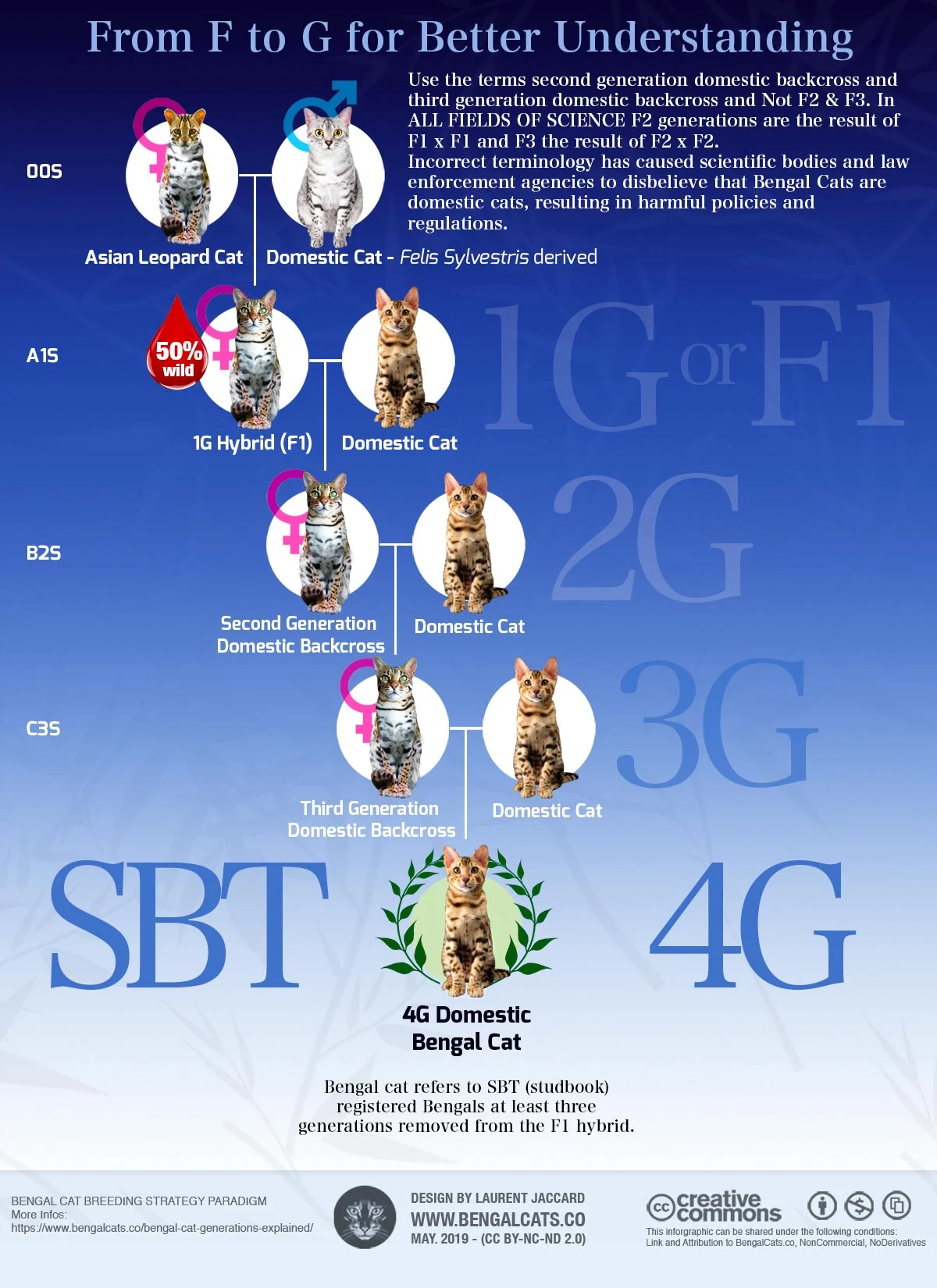Amazing Character of the Bengal Cat
Is the Bengal cat the right breed for you? Well, here’s the bottom line. Don’t get a Bengal if you’re looking for a sweet, gentle lap cat.
This is not a delicate cat. The Bengal cat is a long, muscular, athletic, medium to large sized cat. This is a highly active and athletic cat with the grace of a jungle cat. Because of their high intelligence and wild ancestry, Bengal cats tend to have some strange behavioral quirks.
The Bengal cat has a very lush, soft coat and distinct leopard-like spots. The coat is sometimes referred to as “glittered” because it can have an iridescent shine. The coat can be spotted, marbled, bull’s eye or rosette. The preferred colors are black or brown spotted, or black or brown marbled.
This cat can move quietly and with great stealth. The back legs are slightly longer than the front legs, so the hind end sits a little higher than the shoulders, which lends to this breed’s wild appearance.
The Bengal cat is the result of breeding a small, wild Asian leopard cat with a domestic shorthair. Jean S. Mill began the Bengal cat breeding program in 1963. Today, Bengals are considered to be one and the same with domestic cats, and they should be at least four generations removed from any ancestors with wild bloodlines. The International Cat Association granted the breed experimental status in 1983, followed by full recognition in 1991.
Bengal Cat Personality, Temperament and Traits
The Bengal cat may not be the cat for everyone – especially not for first-time cat owners. The Bengal cat personality makes this cat fun to live with, but he can sometimes be challenging. The Bengal cat is very friendly. He is always alert and he notices everything. The Bengal cat is extremely intelligent, curious and active, and demanding of a lot of interaction.
When a Bengal cat gets bored, he can get into things and become destructive. He can take things apart to see how they work, and he can even open draws and cabinets to see what he can find. Be sure to hide your jewelry from your Bengal cat because he loves to take things and hide them.
The Bengal cat personality is playful, so keep your Bengal cat entertained. He enjoys playing games and likes a good game of fetch. Give the Bengal cat a good puzzle toy that will challenge his intelligence and he’ll be hooked! Bengals also like learning tricks. You should reward them with treats when they learn a trick or master a new puzzle game. Bengal cats also enjoy the attention they get from clicker training.
The Bengal cat loves water play. That means the Bengal might jump into the tub or shower with you, or swim alongside you in the swimming pool. A Bengal cat loves a running faucet. When drinking from his water bowl, a Bengal cat may dip his paw into the water and lick the water from his paw, and he may enjoy splashing the water out of his bowl. He will also enjoy a nice pet drinking fountain. Be wary of having an aquarium with a Bengal cat.
Bengal cats love to climb, and they need a lot of vertical territory. The higher up, the better – they can often be found perched at the highest reachable point in the home, wherever that may be. Cat trees are a very good diversion for a Bengal cat.
These highly intelligent cats are avid hunters and fishers. They love to catch fish and small animals.
The Bengal cat personality is very friendly. The Bengal can be an affectionate breed if he is raised properly. He is not a lap cat, but he enjoys human company and will stay close to his humans. Bengal cats love people and will do anything to get attention from them. Even if the Bengal cat figures out that you don’t like something he does, he will continue to do it again and again just to get your attention and to get you to interact with him. The Bengal cat personality is fond of children. Bengal cats enjoy playing games and interacting with energetic children.
Bengal cats are big talkers. This breed is very vocal and loves to talk to their humans.
All cats are different, but most Bengal cats will get along well with other pets, including dogs. Bengal cats can be territorial, so if you want to have more than one cat it is a good idea to get the cats at the same time.
History of the Bengal

While Jean Mill is considered the founder of the Bengal breed as we know it today, recorded history of the first Asian Leopard cat hybridization goes back to the late 1800s through Harrison Weir in his book Our Cats and All About Them. Wild cats and their hybrids were an early fascination for the fancy – especially those with spots- as it was an Ocelot that won the “Wild or Wild and Domestic Cat Class” in the 1875 cat show in Edinburgh, Scotland. While these pairings continue to happen in Belgium in the 1930s and Japan in the 1940s, there is no record of them actually contributing to the Bengal breed as we know it today.
In the 1960s Loma Linda University Medical Center professor of pediatrics and maternal health, Dr. Willard Centerwall, took interest in the Asian Leopard Cat’s immunity to the feline leukemia virus. Dr. Centerwall, a fan of the cat fancy and feline genetics, spearheaded a research project on the Asian Leopard cat in order to further his understanding of humans with compromised immune systems and to determine if the Asian Leopard cat could pass its immunity through hybridization. Because human leukemia behaves in much the same way as feline leukemia, there was great hope that studying the Asian Leopard cats and their hybrid offspring would lead to a greater understanding of leukemia in general. While the experiment didn’t produce the desired result of passing the resistance on to hybrid offspring, it did, in essence, lead to the creation of the Bengal breed.
In 1980, Jean Sudgen Mill received her first hybrid cats from Dr. Centerwall. She had another purpose in mind for these beautiful hybrids. Jean saw the hybridization of the Asian Leopard Cat as a way to minimize the exploitation of small spotted wild cats for fur and to offer an alternative to people keeping illegal wild cats as pets. In addition, she hoped that if these spotted cats became popular, it would decrease people’s desire for real furs as fashion, as one would not want to wear the cats they have as pets. Thus, the Bengal cat was created in hopes to help save the small wild cat populations.
Jean Mill, however, was not the only one with this idea in mind. In the 1970s, Bill Engler, a zoo keeper, bred his Asian Leopard cat to two domestic cats and created hybrids. He, too, was hopeful that these hybrids could help save the decreasing small wildcat populations. While many believe that the Bengal cat got its name from the Asian Leopard cat’s scientific name – felis bengalesis – Some claim it was actually Bill Engler who gave the breed its name which is perhaps a shortened version of his own B.Engle. The name, however, is the only contribution Mr. Engler left. While it seems Bill made it down three generations, his pursuit ended with his death in 1977 and much like the very first hybrids of the early 1900s, none of Bill Engler’s cats contributed to the Bengal breed.
And so, the fate of the create of hybrids that looked like wildcats ended up in the hands of Jean Mill who in 1980 happily took the left over hybrids from Dr. Centerwall’s project and created the cats that originated what we now know to be the Bengal breed. JEan was able to aquire her own Asian Leopard cat, Kabuki, and, in order to move the generation down the line, she brought in a domestic street cat from India Millwood Tory of Delhi. There were others, such as Doctors Greg and Elizabeth Kent, who were crossing their Egyptian Maus to there Asian Leopard cat Baghara Kahn. While many breeders worked together to get the breed off the ground, it was Jean Mill who worked to get them accepted as a registered breed through TICA and began to show them around the world.
Bengal Cat Coat: Colors and Patterns
Bengal cats are more than small, domestic versions of their larger cousins from the jungle.
There is a wide range of colors, shades and patterns within the Bengal breed.
Depending on both parent’s genetic background, kittens within the same litter, can be very different from one another. Fortunately, the mapping of the feline genome allowed the genes that control coat, color and pattern in cats, to be studied and identified with DNA tests.
Strictly speaking, there are only three basic breed-accepted colors: Brown, Silver and the three Snow colors (Seal Lynx, Seal Sepia and Seal Mink Point). Within each color category, there are two accepted types of pattern: Spotted and Marble.
Like other breeds of cats, Bengals come in a variety of colors.

There are about 6 Bengal cat colors, divided into standard and non-standard by The International Cat Association (TICA).
- The standard Bengal colors are:
- Brown
- Snow
- Silver
- Non-recognized colors are:
- Charcoal
- Blue
- Melanistic (Solid Black)

Why choose a Bengal?
Bengals are among the most exotic and coolest domesticated cats out there.
Bengals are famous for their “like a dog” behavior.
Bengals are known as very distinctive, intelligent and loyal cats with a great character. They are smart enough to be trained and able to walked on the leash.
Bengals are hypoallergenic, meaning that most people allergic to cats will not be affected by them.
Bengals short pelt with beautiful leopard spots gives minimal shedding and feels like velvet when touching.
Bengals have awesome personality and are highly energetic. Kids love to play with them.
Bengals are considered as a healthy breed with only fewgenetic issuesrelated to most pure breads.
Bengals are the size of a medium-large household cat.

BENGAL BREED STANDARD TICA
TICA is The International Cat Association.
Here at BlackAceBengal we take pride in how closely our cats represent the true Bengal Standard:
COLORS:
Brown Tabby, Seal Sepia Tabby, Seal Mink Tabby, Seal Lynx Point, Black Silver Tabby, Seal Silver, Sepia Tabby, Seal, Silver Mink Tabby, Seal Silver Lynx Point.
Spotted or Marbled Patterns ONLY.
HEAD:
Shape: Broad modified wedge with rounded contours. Longer than it is wide. Slightly small in proportion to body, but not to be taken to extreme. The skull behind the ears makes a gentle curve and flows into the neck. Allowance to be made for jowls in adult males. Overall look of the head should be as distinct from the domestic cat as possible.
Ears:
Medium to small, relatively short, with wide base and rounded tops. Set as much on side as top of head, following the contour of the face in the frontal view, and pointing forward in the profile view. Light horizontal furnishings acceptable; but lynx tipping undesirable.
Eyes:
Oval, almost round. Large, but not bugged. Set wide apart, back into face, and on slight bias toward base of ear. Eye color independent of coat color except in the lynx points. The more richness and depth of color the better.
Chin:
Strong chin, aligns with tip of nose in profile.
Muzzle:
Full and broad, with large, prominent whisker pads and high, pronounced cheekbones. Slight muzzle break at the whisker pads.
Nose:
Large and wide; slightly puffed nose leather.
Profile:
Curve of the forehead should flow into the bridge of the nose with no break. Bridge of nose extends above the eyes; the line of the bridge extends to
the nose tip, making a very slight, to nearly straight, concave curve.
Neck:
Long, substantial, muscular, in proportion to the head and body.
BODY:
Torso:
Long and substantial, not oriental or foreign. Medium to large (but not quite as large as the largest domestic breed).
Legs:
Medium length, slightly longer in the back than in the front.
Feet:
Large, round, with prominent knuckles.
Tail:
Medium length, thick, tapered at end with rounded tip.
Boning:
Sturdy, firm; never delicate.
Musculature:
Very muscular, especially in the males, one of the most distinguishing features.
GENERAL DESCRIPTION:
The goal of the Bengal breeding program is to create a domestic cat which has physical features distinctive to the small forest-dwelling wildcats, and with the loving, dependable temperament of the domestic cat. Keeping this goal in mind, judges shall give special merit to those characteristics in the appearance of the Bengal which are distinct from those found in other domestic cat breeds. A Bengal cat is an athletic animal, alert to its surroundings; a friendly, curious, confident cat with strength, agility, balance and grace. It is a medium to large cat which exhibits a very muscular and solid build. Its wide nose with prominent whisker pads and large oval, almost round eyes in a slightly small head enhance the wild appearance and expressive nocturnal look. Its very slight, to nearly straight, concave profile and relatively short ears with wide base and rounded tips add to the Bengal’s distinctive and unique appearance. The short, dense coat has a uniquely soft and silky feel. The coat may be glittered or not glittered, with neither type to be given preference. A thick, low-set, medium-length tail adds balance to the cat.
ALLOWANCES:
Smaller size, in balanced proportion, of females. Slightly longer coat in kittens. Jowls in adult males. Eyes slightly almond shaped. Mousy undercoat. Paw pads not consistent with color group description.
PENALIZE:
Spots on body running together vertically forming a mackerel tabby pattern on spotted cats; circular bulls-eye pattern on marbled cats; substantially darker point color (as compared to color of body markings) in Seal Sepia, Seal Mink, or Seal Lynx Point cats. Any distinct locket on the neck, chest, abdomen or any other area.

